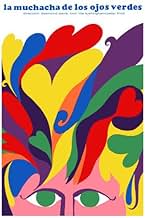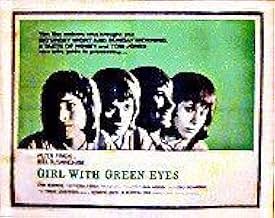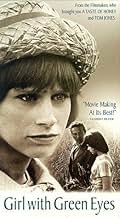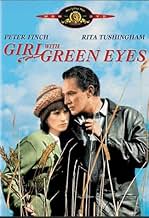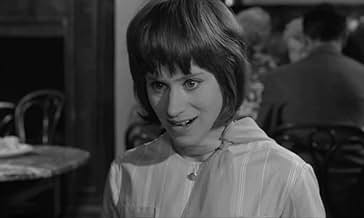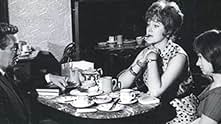IMDb RATING
6.9/10
1.6K
YOUR RATING
In 1960s Dublin a young girl becomes involved with an older man, a much-travelled and still-married landowner.In 1960s Dublin a young girl becomes involved with an older man, a much-travelled and still-married landowner.In 1960s Dublin a young girl becomes involved with an older man, a much-travelled and still-married landowner.
- Nominated for 2 BAFTA Awards
- 3 wins & 3 nominations total
Marie Kean
- Josie Hannigan
- (as Maire Kean)
Liselotte Goettinger
- Joanna
- (as Lislott Goettinger)
Pat Laffan
- Bertie Counham
- (as Patrick Laffan)
Michael C. Hennessy
- Davey
- (as Michael Hennessy)
Joseph O'Donnell
- Patrick Devlin
- (as Joe O'Donnell)
Michael O'Brien
- The Lodger
- (as Micheal O'Briain)
David Kelly
- Ticket Collector
- (as Dave Kelly)
Featured reviews
Long into watching this studiously "small," slice-of-life portrait of a naive young woman, I was still wondering if the film would turn out, in the end, to have been worth watching. Earnest in its desire to be grittily true-to-life, in the neo-realist manner of the Angry Young Men, it is also clearly intoxicated with the quotidian lyricism and plain-spoken poetry of la nouvelle vague. It attempts to be charming and brutally frank at the same time, and manages, to some extent, to carry it off.
But will we end up caring about Tushingham's somewhat obtuse small town escapee, or Finch's sophisticated cold fish? Or will we be left with the rather sodden sensation that we've wasted our time eavesdropping on bores? For my part, I was pleasantly surprised. The story ends with the palpable sense that Kate has grown up a bit, and Eugene has grown a little older and sadder. We've looked on as two people have lived their bittersweet lives, much as we live our own -- and we're a little sad to bid them adieu.
To sum up: not as fresh and appealing today as it probably seemed in its time, but still rewarding and worthwhile.
But will we end up caring about Tushingham's somewhat obtuse small town escapee, or Finch's sophisticated cold fish? Or will we be left with the rather sodden sensation that we've wasted our time eavesdropping on bores? For my part, I was pleasantly surprised. The story ends with the palpable sense that Kate has grown up a bit, and Eugene has grown a little older and sadder. We've looked on as two people have lived their bittersweet lives, much as we live our own -- and we're a little sad to bid them adieu.
To sum up: not as fresh and appealing today as it probably seemed in its time, but still rewarding and worthwhile.
This film is based upon the second volume of Edna O'Brien's "Country Girls" trilogy. That novel was originally published as "The Lonely Girl", but for some reason this was changed in the film adaptation to "Girl with Green Eyes", even though it was made in black and white so one cannot tell what colour the main character's eyes are. Subsequent editions of the book were also entitled "Girl with Green Eyes".
The title character is Kathleen "Kate" Brady, a naive young girl from the rural west of Ireland, who moves to Dublin, where she works in a grocer's shop and shares a room with her friend and schoolmate, Barbara "Baba" Brennan. (Baba is only a secondary character in "Girl with Green Eyes", but she plays a more central role in the other two episodes of the trilogy). Kate hopes to find a boyfriend, but she is shy and naïve and has less success than the more worldly-wise Baba. Eventually, however, Kate becomes involved with the middle-aged Eugene Gaillard, and it is their romance which forms the main subject-matter of the film. (In the original novel Eugene was a film-maker, but here he becomes a writer).
The age difference between Kate and Eugene is not the only obstacle in the way of their relationship. She is a devout Catholic and he a freethinker who does not share her faith. To make matters worse, he is married with a child. He is separated from his wife, but the two are not formally divorced. (At the period when the film is set, divorce was not possible in the Irish Republic; Mrs Gaillard, an American by birth, has had to return to her native country in order to obtain one). Kate's widowed father is horrified by the idea that his daughter is involved with a married man and he descends on Dublin with a group of friends, virtually kidnapping Kate and forcing her to return home, although at the first opportunity she can get she runs back to Eugene.
When the "Country Girls" trilogy was first published, between 1960 and 1963, it caused great controversy in O'Brien's native Ireland. It could be published in Britain but was banned in the Republic, and copies of the books were publicly burned. (It seems that the only freedom the Irish people had gained by secession from the UK was the freedom to be less free than their neighbours). It is therefore surprising that permission was given to make the film in Dublin and other Irish locations, even though it was made in 1964, only a hear after the final instalment in the trilogy had come out.
The film was, however, made by a British production company, Woodfall Film Productions, and the leading actors were all either British (Rita Tushingham as Kate, Lynn Redgrave as Baba) or Australian (Peter Finch as Eugene). Despite the Irish setting, it was made in the "kitchen sink" social-realist style popular in Britain in the late fifties and sixties. Woodfall had earlier made other films in this style, such as "A Taste of Honey", which also starred Tushingham, and "The Loneliness of the Long Distance Runner", both directed by Tony Richardson, who acted as executive producer for "Girl with Green Eyes". The director, however, was Desmond Davis, making his directorial debut after working as a cameraman. .
At the time, the "kitchen sink" school was hailed as marking a new departure in British film-making, although the vogue for films of this nature was to be a relatively brief one, and did not really survive into the seventies (not, by any means, the most distinguished decade in British cinema history). "Spring and Port Wine" from 1970 can be seen as marking the end of the line. Nevertheless, that brief period saw some films of genuine quality and gave a voice to the British working class who had previously been neglected by the country's film-makers.
There are first-rate performances from Tushingham as Kate, a much more sensitive and vulnerable figure than her Jo in "A Taste of Honey", and from Finch as Eugene, a rather more sympathetic figure than he is in the book, a sophisticated, intellectual type who is at first flattered by the attentions of a younger woman, but who realises that the differences between them are too great to be easily overcome. "Girl with Green Eyes" is perhaps less well-known today than films like "Saturday Night and Sunday Morning", "A Taste of Honey" or "The Loneliness...", but I think it deserves to be better remembered.
The title character is Kathleen "Kate" Brady, a naive young girl from the rural west of Ireland, who moves to Dublin, where she works in a grocer's shop and shares a room with her friend and schoolmate, Barbara "Baba" Brennan. (Baba is only a secondary character in "Girl with Green Eyes", but she plays a more central role in the other two episodes of the trilogy). Kate hopes to find a boyfriend, but she is shy and naïve and has less success than the more worldly-wise Baba. Eventually, however, Kate becomes involved with the middle-aged Eugene Gaillard, and it is their romance which forms the main subject-matter of the film. (In the original novel Eugene was a film-maker, but here he becomes a writer).
The age difference between Kate and Eugene is not the only obstacle in the way of their relationship. She is a devout Catholic and he a freethinker who does not share her faith. To make matters worse, he is married with a child. He is separated from his wife, but the two are not formally divorced. (At the period when the film is set, divorce was not possible in the Irish Republic; Mrs Gaillard, an American by birth, has had to return to her native country in order to obtain one). Kate's widowed father is horrified by the idea that his daughter is involved with a married man and he descends on Dublin with a group of friends, virtually kidnapping Kate and forcing her to return home, although at the first opportunity she can get she runs back to Eugene.
When the "Country Girls" trilogy was first published, between 1960 and 1963, it caused great controversy in O'Brien's native Ireland. It could be published in Britain but was banned in the Republic, and copies of the books were publicly burned. (It seems that the only freedom the Irish people had gained by secession from the UK was the freedom to be less free than their neighbours). It is therefore surprising that permission was given to make the film in Dublin and other Irish locations, even though it was made in 1964, only a hear after the final instalment in the trilogy had come out.
The film was, however, made by a British production company, Woodfall Film Productions, and the leading actors were all either British (Rita Tushingham as Kate, Lynn Redgrave as Baba) or Australian (Peter Finch as Eugene). Despite the Irish setting, it was made in the "kitchen sink" social-realist style popular in Britain in the late fifties and sixties. Woodfall had earlier made other films in this style, such as "A Taste of Honey", which also starred Tushingham, and "The Loneliness of the Long Distance Runner", both directed by Tony Richardson, who acted as executive producer for "Girl with Green Eyes". The director, however, was Desmond Davis, making his directorial debut after working as a cameraman. .
At the time, the "kitchen sink" school was hailed as marking a new departure in British film-making, although the vogue for films of this nature was to be a relatively brief one, and did not really survive into the seventies (not, by any means, the most distinguished decade in British cinema history). "Spring and Port Wine" from 1970 can be seen as marking the end of the line. Nevertheless, that brief period saw some films of genuine quality and gave a voice to the British working class who had previously been neglected by the country's film-makers.
There are first-rate performances from Tushingham as Kate, a much more sensitive and vulnerable figure than her Jo in "A Taste of Honey", and from Finch as Eugene, a rather more sympathetic figure than he is in the book, a sophisticated, intellectual type who is at first flattered by the attentions of a younger woman, but who realises that the differences between them are too great to be easily overcome. "Girl with Green Eyes" is perhaps less well-known today than films like "Saturday Night and Sunday Morning", "A Taste of Honey" or "The Loneliness...", but I think it deserves to be better remembered.
It's just an episode but charmingly well done, Rita Tushingham shining with her eyes all through the film, well seconded by the slightly more reticent and laconic Peter Finch as the middle-aged writer with a failed family behind him and no illusions left, trying to be alone working by writing, which is difficult as Rita Tushingham keeps haunting him, and his family in America making themselves reminded by commenting on an aging man's relationship with a teenage girl with no experience - it could have been equivocal, but it isn't at all, since it is set in Ireland among angily bigotted catholics who also object against the unorthodox relationship and even try to do something about it by hard methods - there is some drama on the way. Lynn Redgrave assists Rita as well as she could and actually saves the situation in the end.
I saw this film when it was new, it was likeable enough already then, but made no lasting impression, wherefore I gave it a chance 50 years later just to refresh my memory and see what it really was all about - but it imported nothing new. It was still just an episode, charmingly well done, with the Rita's shining eyes and Peter's morose introversions - well done, indeed, but hardly universal, just local.
I saw this film when it was new, it was likeable enough already then, but made no lasting impression, wherefore I gave it a chance 50 years later just to refresh my memory and see what it really was all about - but it imported nothing new. It was still just an episode, charmingly well done, with the Rita's shining eyes and Peter's morose introversions - well done, indeed, but hardly universal, just local.
Poor Rita Tushingham--she did seem to inherit some strangely frustrating parts.
In "A Taste of Honey" she was a young pregnant girl, first abandoned by her itinerant sailor, then landing in a "relationship" with a sadly confused chap.
In "Girl with Green Hair," she's another adolescent who falls for a man twice her age. Won't she ever learn?
Director Desmond Davis' work resembles Tony Richardson's so much that their styles are almost interchangeable. It may be because Composer John Addison also scored Richardson's "A Taste of Honey," and "Loneliness of the Long Distant Runner." It's remarkable how Addison's bleakly dissonant style so greatly influences the moods of these dramas.
With Davis employing a lot of contrapuntal passages played by a thin woodwind ensemble--often featuring a solo oboe--one does feel the emptiness and loneliness of character emotions.
There was no one who embodied the "Cockney Kitchen Sink" dramas of the 60s like Tushingham. She was perfect for her parts. Here ably supported by Peter Finch as a blase older man and Lynn Redgrave as a daftly talkative friend, Tushingham plays her role to the hilt.
By the end, the viewer has come to experience a limited encounter--rather doomed from the start--between a worldly wise Dublin land owner and working class Brit girl . . . the latter of whom is finally able to move on with her education and find acquaintances more her age.
The viewer during this visit has experienced some telling scenes of Irish-English life, and an interesting adolescent/mature fling at a brief encounter.
In "A Taste of Honey" she was a young pregnant girl, first abandoned by her itinerant sailor, then landing in a "relationship" with a sadly confused chap.
In "Girl with Green Hair," she's another adolescent who falls for a man twice her age. Won't she ever learn?
Director Desmond Davis' work resembles Tony Richardson's so much that their styles are almost interchangeable. It may be because Composer John Addison also scored Richardson's "A Taste of Honey," and "Loneliness of the Long Distant Runner." It's remarkable how Addison's bleakly dissonant style so greatly influences the moods of these dramas.
With Davis employing a lot of contrapuntal passages played by a thin woodwind ensemble--often featuring a solo oboe--one does feel the emptiness and loneliness of character emotions.
There was no one who embodied the "Cockney Kitchen Sink" dramas of the 60s like Tushingham. She was perfect for her parts. Here ably supported by Peter Finch as a blase older man and Lynn Redgrave as a daftly talkative friend, Tushingham plays her role to the hilt.
By the end, the viewer has come to experience a limited encounter--rather doomed from the start--between a worldly wise Dublin land owner and working class Brit girl . . . the latter of whom is finally able to move on with her education and find acquaintances more her age.
The viewer during this visit has experienced some telling scenes of Irish-English life, and an interesting adolescent/mature fling at a brief encounter.
The only thing I had seen before this by Desmond Davis, was the classic "Clash of the Titans." That was perhaps the best movie ever made based on ancient Greek Mythology. It was a wonderful adventure and fantasy film.
This is totally different. It is British new wave with a camera that tracks, sweeps and runs across the British/Irish countryside as gently as it tickles Rita Tushingham's large nosed, perky face. Besides the energetic cinematography and editing which is somewhere between Goddard's "Breathless" and Richard Lester's "A Hard Day's Night," we get a hard edge slice of life drama/comedy that leaps with wit and poetry. Its as good as Tushingham's earlier, similar hit, "A Taste of Honey."
Lynn Redgrave is cuter than any human being has a right to be and Peter Finch is honest and likable as Eugene, the man who wins Tushingham's confidence, if not her heart.
The point of the movie is that we all change and we even "outgrow our friends". We should accept it without getting hysterical or dramatic about it. It is a touch sad, but we move on.
In a way it belongs with "My Fair Lady," and "Educating Rita" as a picture about women becoming...
All one can say about the movie in its entirety: "Smashing!"
This is totally different. It is British new wave with a camera that tracks, sweeps and runs across the British/Irish countryside as gently as it tickles Rita Tushingham's large nosed, perky face. Besides the energetic cinematography and editing which is somewhere between Goddard's "Breathless" and Richard Lester's "A Hard Day's Night," we get a hard edge slice of life drama/comedy that leaps with wit and poetry. Its as good as Tushingham's earlier, similar hit, "A Taste of Honey."
Lynn Redgrave is cuter than any human being has a right to be and Peter Finch is honest and likable as Eugene, the man who wins Tushingham's confidence, if not her heart.
The point of the movie is that we all change and we even "outgrow our friends". We should accept it without getting hysterical or dramatic about it. It is a touch sad, but we move on.
In a way it belongs with "My Fair Lady," and "Educating Rita" as a picture about women becoming...
All one can say about the movie in its entirety: "Smashing!"
Did you know
- TriviaIn the montage of the girls getting ready for their dates near the movie's beginning, the 45 r.p.m. record is "Fell In Love On Monday" by Fats Domino, who is also the topic of the magazine article near the record.
- Quotes
Malachi Sullivan: Ah, the milk of human blindness.
- ConnectionsFeatured in Talkies: Remembering Dora Bryan/Our Dora (2019)
- How long is Girl with Green Eyes?Powered by Alexa
Details
- Release date
- Country of origin
- Languages
- Also known as
- La muchacha de los ojos verdes
- Filming locations
- Wellington Monument, Phoenix Park, Dublin, County Dublin, Ireland(Kate & Eugene and later Kate & Baba go there)
- Production company
- See more company credits at IMDbPro
Box office
- Budget
- £140,000 (estimated)
- Runtime1 hour 31 minutes
- Color
- Aspect ratio
- 1.66 : 1
Contribute to this page
Suggest an edit or add missing content

Top Gap
By what name was La fille aux yeux verts (1964) officially released in India in English?
Answer

